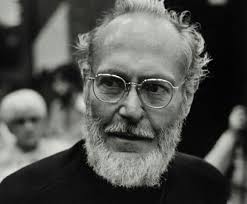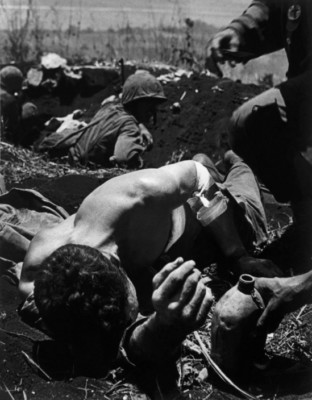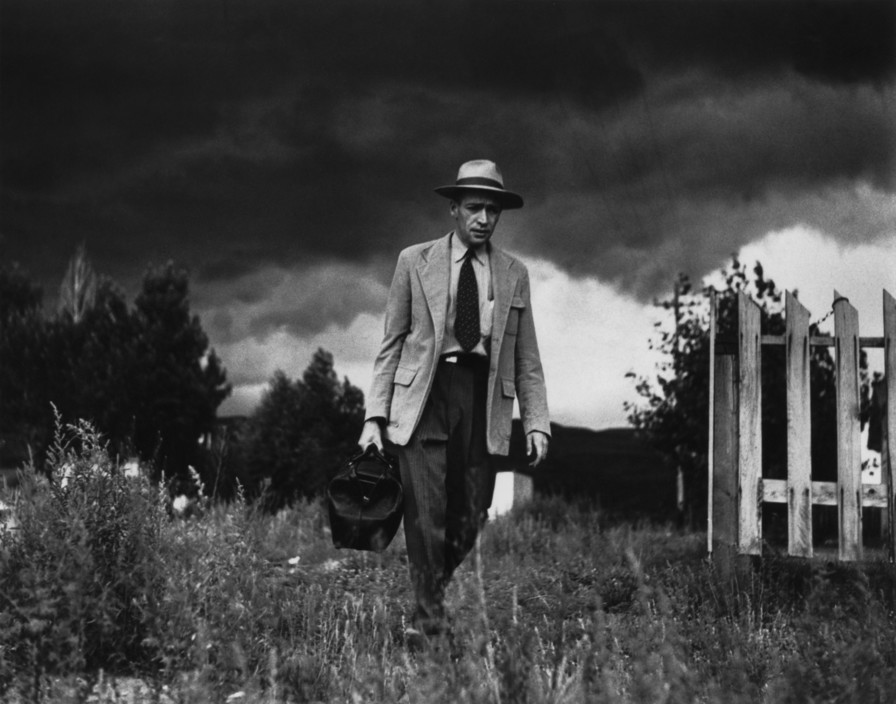


W. Eugene Smith
Jump to navigation Jump to search
|
This article needs additional citations for verification. (September 2017) (Learn how and when to remove this template message)
|
|
W. Eugene Smith
|
|
|---|---|

Smith and wife Aileen M. Smith, 1974
|
|
| Born |
William Eugene Smith
December 30, 1918 |
| Died | October 15, 1978 (aged 59)
Tucson, Arizona, USA
|
| Occupation | Photojournalist |
William Eugene Smith (December 30, 1918 – October 15, 1978) was an American photojournalist.[1] He has been described as “perhaps the single most important American photographer in the development of the editorial photo essay.”[2] His major photo essays include World War II photographs, the dedication of an American country doctor and a nurse midwife, the clinic of Dr Schweitzer in French Equatorial Africa, the city of Pittsburgh, and the pollution which damaged the health of the residents of Minamata in Japan.[3] His 1948 series, Country Doctor, photographed for Life magazine is now recognized as “the first extended editorial photo story”.[2]
William Eugene Smith was born in the city of Wichita, Kansas on December 30, 1918 to William H. Smith and Nettie Lee. Growing up, Smith had taken interest in flying and aviation. When the little boy was only nine years old and asking his mother for money to buy photographs of airplanes, the child was given his first camera. In 1927 Nettie gave him her old camera in hopes that he would begin to take his own photographs. Though this is what birthed Smith’s vocation. When her nine year old boy, who would later become the most esteemed photographer in history, came to her with a full roll of shots, she would develop the film for him in her own homemade darkroom.[1]
Smith started grade school in his home town of Wichita. He started Catholic school in 1924, before he was handed a camera. By the time he was a teenager, photography was his passion and his craft. He began his journey as a professional and serious photographer when the famous Frank Noel of the Wichita Press approached him. Noel, impressed with his photography, pushed him to submit his works to the news sources.[4] By the time Smith was fifteen years old he was published in The Wichita Eagle and the Wichita Beacon.[1]
Smith graduated from the Wichita North High School in 1936. That same year, his father committed suicide. In the aftermath of his father’s death, Smith’s morals and values were carved into stone. Salt was thrown into the wounds he and his mother endured when the news of the town used the story and twisted the death into a falsity. The truth of the circumstances of the situation had been lost. It was in this series of unfortunate events that lit the flame for Smith to begin his career in photojournalism. He made a promise to hold himself to the highest standards of truth no matter the cost.[4]
Smith moved to New York City and by 1938 he had begun to work for Newsweek. He became known there for his incessant perfectionism and thorny personality and eventually Smith was fired from Newsweek. He later explained that Newsweek wanted him to work with larger format negatives, but he refused to abandon the 35mm Contax camera he preferred to work with.[5] Smith began to work for Life magazine in 1939, quickly building a strong relationship with then picture editor Wilson Hicks.[6]
War work
As a correspondent for Ziff-Davis Publishing, and then at Life, Smith took photos on the front lines in the Pacific theater of World War II. He was with the American forces during their island-hopping offensive against Japan, photographing U.S. Marines and Japanese prisoners of war at Saipan, Guam, Iwo Jima, and Okinawa. In 1945, Smith was seriously injured by mortar fire while photographing the Battle of Okinawa.
In 1946, he took his first photograph since being injured: a picture of his two children walking in the garden of his home in Tuckahoe, New York, which he titled The Walk to Paradise Garden. The photograph became enormously famous when Edward Steichen used it as one of the key images in the exhibition The Family of Man, which Steichen curated in 1955.[7] After spending two years undergoing surgery, Smith continued to work at Life until 1954.[8]
1950s
In 1950, Smith was sent to the UK to cover the General Election, in which the Labour Party, under Clement Attlee, was elected with a tiny majority. Life had taken an editorial stance against the Labour government. In the end, a limited number of Smith’s photographs of British working class people were published, including three shots of the South Wales Valleys. In a documentary made by BBC Wales, Dai Smith traced a miner who described how he and two colleagues had met Smith on their way home from work at the pit and had been instructed on how to pose for one of the photographs published in Life.
Between 1948 and 1954 Smith photographed for Life magazine a series of photo essays with a humanist perspective which laid the basis of modern photojournalism, and which were, in the estimate of Encyclopædia Britannica, “characterized by a strong sense of empathy and social conscience.”[9]
In August 1948 Smith photographed Dr. Ernest Ceriani in the town of Kremmling, Colorado, for several weeks, covering the doctor’s arduous work in a thinly populated western environment, grappling with life and death situations. (One of the most vivid images shows Ceriani looking exhausted in a kitchen, having performed a Caesarean section during which both mother and baby died.)[2] The essay Country Doctor was published by Life on September 20, 1948.[10] It has been described by Sean O’Hagan as “the first extended editorial photo story”.[2]
Smith spent a month in Spain in 1950, photographing the village of Deleitosa, Extremadura, focusing on themes of rural poverty.[11] Smith attracted the suspicion of the local Guardia Civil, until he finally made an abrupt exit across the border to France. A Spanish Village was published in Life on April 9, 1951 to great acclaim. Ansel Adams wrote Smith a letter of praise, which Smith carried in his pocket for three years, unable to write a reply.[11]
In 1951, Smith persuaded Life editor Edward Thompson to let him do a photo-journalistic profile of Maude E. Callen, a black nurse midwife working in rural South Carolina. For weeks Smith accompanied Callen on her exhausting schedule, rising before dawn and working into the evening. The essay Nurse Midwife was published in Life on December 3, 1951.[12] It was well received and resulted in thousands of dollars in donations to create the Maude Callen Clinic, which opened in Pineville, South Carolina in May 1953, with Smith present at the ceremony.[12][13]
In 1954, Smith photographed an extensive photo-essay about the work Albert Schweitzer at his clinic at Lambaréné in Gabon, West Africa.[14] It was later revealed that one of his most famous images had been extensively manipulated.[15] Smith made many layouts of his Schweitzer pictures which he submitted to Life, but the final layout of the story published on November 15, 1954, entitled A Man of Mercy, enraged Smith because editor Edward Thompson used fewer pictures than Smith wanted, and Smith thought the layout crude.[16] He immediately resigned from Life in November 1954.[16]
After leaving Life magazine, Smith joined the Magnum Photos agency in 1955. There he was commissioned by Stefan Lorant to produce a photographic profile of the city of Pittsburgh. The project was supposed to take him a month and to produce 100 images. It ended up occupying more than two years and producing 13,000 photographic negatives. The intended book was never delivered to Lorant, and Smith’s obsessive work was bailed out by money from Magnum, causing strain between Smith and the photo-journalist collective.[17]
Jazz Loft Project
From 1957 to 1965 Smith took photographs and made recordings of jazz musicians playing at a Manhattan loft shared by David X. Young, Dick Cary, and Hall Overton. The Jazz Loft Project, devoted to preserving and cataloging the works of Smith, is directed by Sam Stephenson at the Center for Documentary Studies at Duke University in cooperation with Center for Creative Photography (CCP, part of the University of Arizona) and the Smith estate.[18][19] From 1957 to 1965, Smith made approximately 4,000 hours of recordings on 1,740 reel to reel tapes[20] and nearly 40,000 photographs in a loft building in Manhattan’s wholesale flower district where major jazz musicians of the day gathered and played their music. The tapes have not been played since they were archived at the CCP,[21] following Smith’s death in 1978.[n 1]
The tapes also contain many Smith interests, such as recorded street noise in the flower district, late-night radio talk shows, telephone calls, television and radio news programs, and many random loft dialogues among musicians, artists, and other Smith friends and associates.
Japan and Minamata
Smith and his wife of Japanese origin, Aileen M. Smith, lived in Minamata, both a fishing village and a “one company” industrial city in Kumamoto Prefecture, Japan from 1971 to 1973. There they created a long-term photo-essay on Minamata disease, the effects of mercury poisoning caused by a Chisso factory discharging heavy metals into water sources around Minamata.
In January 1972, Smith was attacked by Chisso Company employees near Tokyo, in an attempt to stop him from further publicizing the effects of Minamata disease to the world.[22] Smith survived the attack, but with limited vision in one eye.[23] During the time Smith was not able to work due to his injuries, Aileen continued the work.
The essay was published in 1975 as “‘Minamata’, Words and Photographs by W.E. Smith and A.M. Smith.” Its centerpiece photograph and one of his most famous works, Tomoko Uemura in Her Bath, taken in December 1971, and published a few months after the 1972 attack, drew worldwide attention to the effects of Minamata disease.[citation needed][n 2] The photograph depicts a mother cradling her severely deformed, naked daughter in a traditional Japanese bathing chamber. This has been withdrawn from circulation in accordance with the parents’ wishes.[24] The photograph was the centerpiece of a Minamata disease exhibition held in Tokyo, in 1974.[25]
Variety reported in 2018 that Johnny Depp will portray Smith in an independent film drama called Minamata.[26]
Move to Arizona and death
Smith returned from his stay in Minamata, Japan, in November 1974, and, after completing the Minamata book, he moved to a studio in New York City with a new partner, Sherry Suris. Smith’s friends were alarmed by his deteriorating health and arranged for him to join the teaching faculty of the Art Department and Department of Journalism at the University of Arizona.[27] Smith and Suris moved to Tucson, Arizona in November 1977. On 23 December 1977, Smith suffered a massive stroke, but made a partial recovery and continued to teach and organize his archive. Smith suffered a second stroke and died on October 15, 1978. He was cremated and his ashes interred in Crum Elbow Rural Cemetery, Hyde Park, New York.[28]
Legacy
Summarizing Smith’s achievements, Ben Maddow wrote that Smith claimed that his vocation was
“to do nothing less than record, by word and photograph, the human condition. No one could really succeed at such a job: yet Smith almost did. During his relatively brief and often painful life, he created at least fifty images so powerful that they have changed the perception of our history.[29]
Writing in The Guardian in 2017, Sean O’Hagan described Smith as “perhaps the single most important American photographer in the development of the editorial photo essay.”[2]
According to the International Center of Photography, “Smith is credited with the developing the photo essay to its ultimate form. He was an exacting printer, and the combination of innovation, integrity, and technical mastery in his photography made his work the standard by which photojournalism was measured for many years.”[30]
W. Eugene Smith Memorial Fund
The W. Eugene Smith Memorial Fund promotes “humanistic photography”.[31] Since 1980, the fund has awarded photographers for exceptional accomplishments in the field.
The Big Book
The Big Book is a conceptual photobook that Smith created at the beginning of the 1960s, intending to serve as retrospective sum of his work as well as a reflection of his life philosophies. Considered “unviable and non-commercial” at the time, due to having 380 pages and 450 images, it was not published at the time, but as part of his legacy, was finally published as a facsimile reproduction in 2013 by the University of Texas Press.[32][33] A large book, the work includes two of Smith’s original volumes, which present his imagery not according to story (as they would have been published at the time of their creation) but rather according to Smith’s own creative process. The modern publication comes with a third book included in the slip-case, offering contemporary essays and notes.
Notable photographs and photo-essays
- 1944 photograph[34] in which a wounded infant is found by an American soldier on Saipan.
- 1945 photograph in which Marines blow up a Japanese cave on Iwo Jima, published on the cover of Life, April 9, 1945.
- “The Walk to Paradise Garden” (1946) – single photograph of his two children walking hand in hand towards a clearing in woods. It was the closing image in the 1955 Museum of Modern Art exhibition, The Family of Man,[35] organized by Edward Steichen with 503 photographs, by 273 photographers from 68 countries.
- “Country Doctor”[36] (1948) – photo essay on Ernest Ceriani in the small Colorado town of Kremmling. It was described by Sean O’Hagan as “the first extended editorial photo story”.[2]
- Spanish Village (1950) – photo essay on the small Spanish town of Deleitosa.
- “Nurse Midwife” (1951) – photo essay on midwife Maude E. Callen in South Carolina.[12][13]
- A Man of Mercy (1954) – photo essay on Albert Schweitzer and his humanitarian work in French Equatorial Africa.
- “Pittsburgh” (1955–1958) – three-year-long project on the city, hired initially by photo editor Stefan Lorant for a three-week assignment.
- Haiti 1958–1959 – photo essay on a psychiatric institute in Haiti.[37]
- “Tomoko Uemura in Her Bath“ (1971) – the centerpiece photograph in Minamata, a long-term photo essay on Minamata disease. The photograph depicts a mother cradling her severely deformed, naked daughter in a traditional Japanese bathing chamber.[25]
Publications
Publications by Smith
- W. Eugene Smith: His Photographs and Notes: an Aperture Monograph. New York: Aperture, 1969. ISBN 9780893815349. With an afterword by Lincoln Kirstein.
- Minamata. New York: Holt, Rinehart and Winston, 1975. By Smith and Aileen M. Smith.
Publications with contributions by Smith
- Steichen, Edward. The Family of Man. New York: Museum of Modern Art, 1955.
Posthumous publications by or about Smith
- W. Eugene Smith: Master of the Photographic Essay. New York: Aperture, 1981. ISBN 0-89381-070-3. Edited with commentary by William S. Johnson. With a foreword by James L. Enyeart.
- Let Truth be the Prejudice: W. Eugene Smith, His Life and Photographs. New York: Aperture, 1985. By Ben Maddow. ISBN 0-89381-179-3. Illustrated biography, exhibition catalogue. With an afterword by John G. Morris.
- W. Eugene Smith: Shadow & Substance: the Life and Work of an American Photographer. New York: McGraw-Hill, 1989. By Jim Hughes. ISBN 9780070311237.
- W. Eugene Smith: Photographs 1934-1975. New York: Abrams, 1998. Edited by Gilles Mora and John T. Hill. ISBN 9780810941915. With texts by Mora, “W. Eugene Smith: the Arrogant Martyr”, Serge Tisseron, “What is a Symbolic Image?”, Alan Trachtenberg, “W. Eugene Smith’s Pittsburgh: Rumours of a City”, Gabriel Bauret, “The Influences of a Legend”, and John T. Hill, “W. Eugene Smith: His Techniques and Process”. The texts by Mora, Bauret and Tisseron were translated from the French by Harriet Mason.
Films
- W. Eugene Smith: Photography Made Difficult (Home Vision, 1989) – 87 minutes. Produced by Kirk Morris, directed by Gene Lasko and written by Jan Hartman. ISBN 9780780007680. Originally broadcast as a segment of American Masters.


W. Eugene Smith

Biography
سيرة شخصية
ولد وترعرع في ويتشيتا ، كانساس ، أصبح ويوجين سميث مهتمًا بالتصوير الفوتوغرافي
في سن الرابعة عشرة ، وبعد ثلاث سنوات بدأ التصوير للصحف المحلية. حصل على منحة
للتصوير الفوتوغرافي في جامعة نوتردام ، لكنه غادر بعد عام إلى نيويورك ،
حيث انضم إلى موظفي نيوزويك وعمل لحسابهم الخاص في لايف ، كولير ، هاربر بازار ،
نيويورك
Smith is credited with the developing the photo essay to its ultimate form. He was an exacting printer, and the combination of innovation, integrity, and technical mastery in his photography made his work the standard by which photojournalism was measured for many years. In recognition of his outstanding contribution to the development of photojournalism, the W. Eugene Smith Memorial Fund was established after his death to support the projects of photographers working in the tradition he established.
Lisa Hostetler
Handy et al. Reflections in a Glass Eye: Works from the International Center of Photography Collection, New York: Bulfinch Press in association with the International Center of Photography, 1999, p. 228.
The definitive biography on W. Eugene Smith was written by Jim Hughes in 1989:
W. Eugene Smith: Shadow and Substance, The Life and Work of an American Photographer.
His research archive was donated to ICP in 2009. The W. Eugene Smith/Jim and Evelyn Hughes Research Archive at ICP







